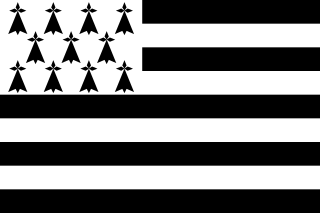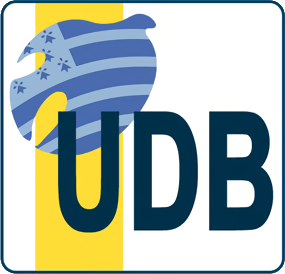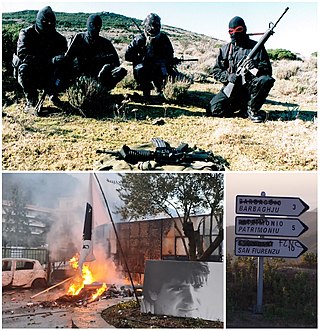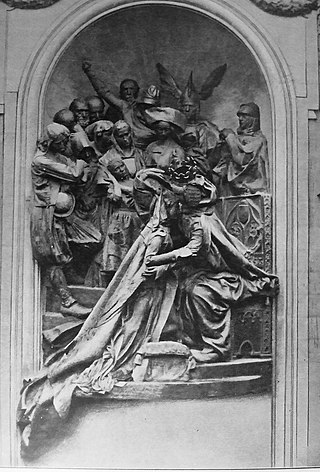
The history of Brittany may refer to the entire history of the Armorican peninsula or only to the creation and development of a specifically Brythonic culture and state in the Early Middle Ages and the subsequent history of that state.

The Breton Liberation Front was a paramilitary organisation founded in 1963 whose aims were to seek greater autonomy for the region of Brittany separate from the rest of France. Brittany is a province in northwest France, and formed an independent Duchy of Brittany until the treaty of union in 1532. The group allegedly had strong allies with ETA as their struggles were almost the same.

The Breton Revolutionary Army is an illegal armed organization that is part of the Breton nationalism movement in the Brittany region of France.
Emgann is a left-wing Breton nationalist movement in Brittany, France. Founded in 1982, it soon became one of the principal groups agitating for Breton independence. They describe themselves as a "Left-wing independentist movement" which "fights for the emancipation and the national liberation of the Breton people and their direct representation in European authorities".
Gwenn ha Du was a paramilitary group founded at the end of 1930 in Paris by Célestin Lainé. It advocated Breton nationalism through "direct action" and published a secret manual aimed at instructing readers in terrorism. The phrase "Gwenn ha du" is the nickname for the Breton flag, which is in these colours.

Breton nationalism is the nationalism of the historical province of Brittany, France. Brittany is considered to be one of the six Celtic nations.

Yann Goulet was a Breton sculptor, Breton nationalist and war-time collaborationist with Nazi Germany who headed the Breton Bagadou Stourm militia. He later took Irish citizenship and became professor of sculpture at the Royal Hibernian Academy.
The Breton Social-National Workers' Movement was a nationalist, separatist, and Fascist movement founded in 1941 by Théophile Jeusset. It emerged in Brittany from a deviationist faction of the Breton National Party; it disappeared the same year.

Olier Mordrel is the Breton language version of Olivier Mordrelle, a Breton nationalist and wartime collaborator with the Third Reich who founded the separatist Breton National Party. Before the war, he worked as an architect. His architectural work was influenced by Art Deco and the International style of Le Corbusier. He was also an essayist, short story writer, and translator. Mordrel wrote some of his works under the pen names Jean de La Bénelais, J. La B, Er Gédour, A. Calvez, Otto Mohr, Brython, and Olivier Launay.

Long before World War II, the various Breton nationalist organizations were often anti-French and anti-colonialist, opposed to the Central Government's policy of linguistic imperialism, and critical to varying degrees of post-French Revolution-style Republicanism. Some Breton nationalists were openly pro-fascist. The extent to which this led Breton nationalists into collaboration with the Axis Powers and their motivations, remains a matter of often bitter historical controversy and debate.
TV Breizh is a private French regional station for the Brittany region.

Breton Democratic Union is a Breton nationalist, autonomist, and regionalist political party in Brittany and Loire-Atlantique. The UDB advocates devolution for Brittany as well as the promotion of its regional languages and its associated culture.

The Battle of Saint-Aubin-du-Cormier took place on 28 July 1488, between the forces of King Charles VIII of France, and those of Francis II, Duke of Brittany, and his allies. The defeat of the latter signalled the end to the "guerre folle", a feudal conflict in which French aristocrats revolted against royal power during the regency of Anne de Beaujeu. It also effectively precipitated the end of the independence of Brittany from France.
The Orly Airport attack was the 15 July 1983 bombing of a Turkish Airlines check-in counter at Orly Airport in Paris, by the Armenian militant organization ASALA as part of its campaign for the recognition of and reparations for the Armenian genocide. The explosion killed eight people and injured 55.

The Corsican conflict is an armed and political conflict on the island of Corsica which began in 1976 between the government of France and Corsican nationalist militant groups. Beginning in the 1970s, the Corsican conflict peaked in the 1980s before Corsican nationalist groups and the French government reached a truce in 2016. It is currently ongoing following the 2022 Corsica unrest.
Paris attacks may refer to the following:

The bombing of the French consulate in West Berlin was a terrorist bomb attack targeting the Maison de France consulate on the Kurfürstendamm in West Berlin, West Germany on 25 August 1983. It killed one person and injured 23 others. The Armenian Secret Army for the Liberation of Armenia (ASALA) claimed responsibility in a telephone call and also took credit for a bomb at a French base in Beirut the same day, coming a month after the group's Orly Airport attack. The group commented "We will continue our struggle until the liberation of innocent Armenians from French jails." However the attack was actually orchestrated by Ilich Ramírez Sánchez, better known as Carlos the Jackal, who had relations with the ASALA's leadership. Carlos claimed responsibility in a letter written to the German Embassy in Saudi Arabia.
Michel Herjean was a French trade unionist and Breton separatist.

The bomb attack of 7 August 1932 in Rennes was aimed at a work by the sculptor Jean Boucher, symbolizing the union of Brittany and France, and placed in a niche in Rennes city hall. Since its inauguration in 1911, the statue, representing Anne of Brittany, had been considered degrading by the Breton movement, due to its kneeling position before the King of France.

The Roc'h Trédudon attack was the destruction of the Roc'h Trédudon transmitter in Plounéour-Ménez, Finistère, by a series of bombs on the night of 13 to 14 February 1974. It was claimed by the Breton independence organization Breton Liberation Front (FLB), and deprived western Brittany of television for several weeks. It took place against a backdrop of the revival of the Breton nationalist movement, and sparked off fierce reactions and controversy as to the true identity of the perpetrators.













